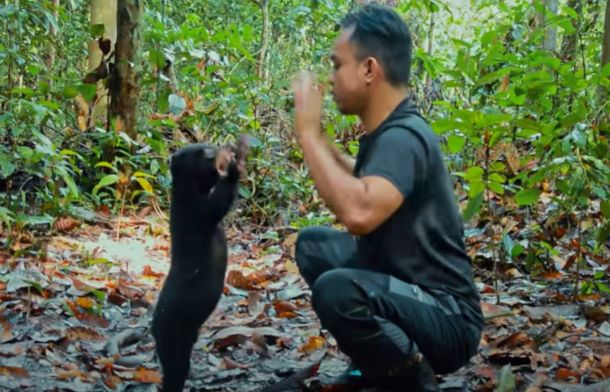Sun bears are the tiniest bears in the animal kingdom. Tenom is a sun bear who lived in captivity after poachers killed her mother and attempted to sell her as a pet. A wildlife rescue team recently began a four-phase plan to train Tenom to live in the wild, essentially teaching her to be a bear.
Videos by InspireMore
Sun bears are identifiable by their yellow-gold chest patch, resembling a necklace around the tiny bear’s neck. As a cub, Tenom is about the size of a small dog. The rehabilitation program expects to train Tenom over two years. Her training period is equivalent to the two to three years a cub would typically be with its mother. Using a “foster family” model, the team will teach the cub how to survive in the wild.

Sun bears are completely hairless at birth and depend on their mothers to supply warmth, food, and protection from predators. Tenom’s foster family, led by Jude (seen above, acting as the momma bear), will provide those vital elements. We mentioned that sun bears are the world’s smallest bears. Adults standing on hind legs are less than three feet tall! Their small size allows them to climb among the rainforest tree canopies easily.
The Importance Of Sun Bears To The Ecosystem
The world’s smallest bear is a vital part of the rainforest ecosystem. They are a “keystone species,” shaping the ecosystem in their territory. First, they dig, stirring up nutrients in the ground that assist other rainforest dwellers. Their claws can also tear up rotted trees, opening cavities for bugs and birds to feed and create homes.

Secondly, they eat various fruits, leaving fertilized seeds everywhere they travel (yes, you think correctly). This creates new growth throughout their wide territory, which is instrumental to the survival of the rainforest. Lastly, they absolutely love feasting on termites. This controls the insect population, saving trees throughout the rainforest.

The Future Looks Better For The World’s Smallest Bear
Planet Wild provides funding to assist the Bornean Sun Bear Conservation Centre (BSBCC) with its rehabilitation efforts. Fewer than 10,000 sun bears remain in the wild, so the BSBCC program can be instrumental in preserving the species’ survival.
Phase one of Tenom’s rehabilitation is a “soft release.” The team transports Tenom to the Tabin Wildlife Reserve, a protected area of the Bornean rainforest that is a natural habitat for sun bears. She will be in a compound with her foster family for about two years, learning to be a bear.

Phase two is a settling-in period. The team works to familiarize Tenom with her new surroundings. She will remain safe in a cage for much of this phase but make short excursions into the rainforest with team members.
Phase three continues Tenom’s training with longer excursions into the rainforest. She returns to the enclosure each night for rest and cuddling with Jude. This is the longest portion of her training. She will remain under Jude’s watchful eye as she roams each day.

Phase four is the final step in the rehabilitation plan. Tenom will go out one day and not return. At this phase, the sun bear’s age roughly equates to a human teenager’s. The decision not to return to the enclosure will be Tenom’s and is a natural part of the bear’s growing process.
Please join us in wishing success to the BSBCC and Planet Wild team as they follow Tenom on this journey. The success of this program can be instrumental in the survival of the world’s smallest bear in the wild.
You can find the source of this story’s featured image here.
Want to be happier in just 5 minutes a day? Sign up for Morning Smile and join over 455,000+ people who start each day with good news.


